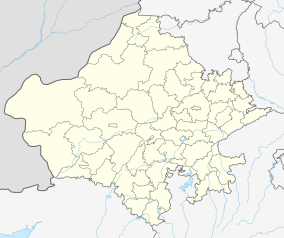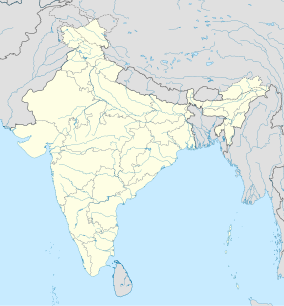Mount Abu Wildlife Sanctuary
| Mount Abu Wildlife Sanctuary | |
|---|---|
 | |
Location in India | |
| Location | Rajasthan, India |
| Nearest city | Mount Abu |
| Coordinates | 24°33′0″N 72°38′0″E / 24.55000°N 72.63333°E |
| Area | 288 km2 (111 sq mi) |
| Established | 1960 |
| Visitors | NA (in NA) |
| Governing body | Ministry of Environment and Forests, Government of India |
Mount Abu Wildlife Sanctuary is located in the Aravalli Range, one of the oldest mountain ranges in India. It was declared a wildlife sanctuary in 1980.[1] The eco-sensitive zone around the sanctuary was notified on 11 Nov 2020.[2]
Geography[edit]
Mount Abu Wildlife Sanctuary spreads out into a plateau which is about 19 km (12 mi) long and 6 km (3.7 mi) wide. In altitude, it ranges from 300 to 1,722 m (984 to 5,650 ft) at Guru Shikhar,[1] the highest peak in Rajasthan. The rocks are igneous and due to the weathering effect of wind and water, large cavities are common in them.
The sanctuary is in the Khathiar-Gir dry deciduous forests ecoregion.[3]
Flora[edit]
It is very rich in floral bio-diversity starting from xenomorphic sub-tropical thorn forests in the foot hills to sub-tropical evergreen forests along PRIYEN water courses and valleys at higher altitudes. There are about 112 plant families with 449 genera and 820 species. Of these, 663 species are dicots while 157 species are monocots.[4] About 81 species of trees, 89 species of shrubs, 28 species of climbers and 17 species of tuberous plants of medicinal importance have been identified in this sanctuary.[5] The rare and endemic plants reported are Dicliptera abuensis Blatt, Carvia colloseeys, Ischaemun kingie,Convolvulus blateri and Ceropegia bulbosa. Some of the native plant species Anogeisus sericea var sericea, Begonia trichocarpa, Crotolaria filipe, Indigofera constricta are listed in Red data book of IUCN[6]
Mount Abu is the only place in Rajasthan where one can observe a variety of orchids. The place is also rich in bryophytes and algae. Three species of wild roses and 16 species of ferns some of which are quite rare have also been reported from here. The south-west part of the sanctuary is rich in bamboo forests.
Fauna[edit]
Among the fauna living in Mount Abu Wildlife Sanctuary are Indian leopard, sloth bear, Sambar deer, wild boar and chinkara.[1] The jungle cat, small Indian civet, Indian wolf, striped hyena, golden jackal, Indian fox, gray langur, Indian pangolin, Indian grey mongoose, Indian hare, Indian crested porcupine and Indian hedgehog have also been recorded. The Asiatic lion was last recorded in 1872, and the Bengal tiger in 1970.[7]
More than 250 species of birds have been recorded including the grey jungle fowl.[8][9] The rare green avadavat is commonly found here.
See also[edit]
References[edit]
- ^ a b c Negi, S. S. (2002). "Mount Abu Wildlife Sanctuary". Handbook of National Parks, Wildlife Sanctuaries and Biosphere Reserves in India (3rd ed.). Indus Publishing. p. 151. ISBN 978-81-7387-128-3.
- ^ Govt of India. "ESZ Notification" (PDF). www.egazette.nic.in. Govt. of India. Retrieved 14 February 2022.
- ^ "Khathiar-Gir dry deciduous forests". Terrestrial Ecoregions. World Wildlife Fund. Retrieved 29 January 2017.
- ^ Mount Abu Wildlife Sanctuary. Retrieved 2 January 2013.
- ^ Mount Abu Wildlife Sanctuary, p. 2. Retrieved 2 January 2013.
- ^ Expert Committee members NGT (December 2020). REPORT BY THE EXPERT COMMITTEE ON The Directions of Hon'ble NGT Order Dated 07.11.2019 in OA No. 312/2016 (MA no. 2012/2019 & MA no. 227/2019) For ECO‐SENSITIVE ZONE (PDF). NGT. p. 59. Retrieved 8 June 2021.
- ^ Sharma, B. K.; Kulshreshtha, S.; Sharma, S.; Singh, S.; Jain, A.; Kulshreshtha, M. (2013). "In situ and ex situ conservation: Protected Area Network and zoos in Rajasthan". In Sharma, B. K.; Kulshreshtha, S.; Rahmani, A. R. (eds.). Faunal Heritage of Rajasthan, India: Conservation and Management of Vertebrates. Heidelberg, New York, Dordrecht, London: Springer Science & Business Media. pp. 3–66. ISBN 9783319013459.
- ^ Storer, R. W. (1988). Type Specimens of Birds in the Collections of the University of Michigan Museum of Zoology (PDF). University of Michigan, Miscellaneous publications No. 174.
- ^ Ali, S.; Ripley, S. D. Handbook of the birds of India and Pakistan. Vol. 2 (Second ed.). Oxford University Press. pp. 106–109.


 French
French Deutsch
Deutsch
